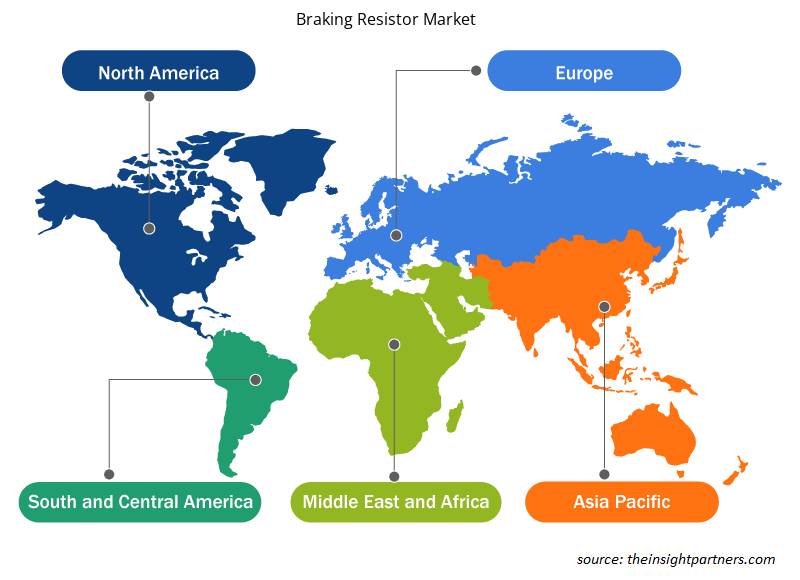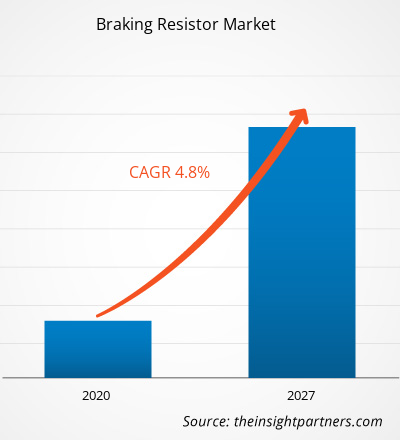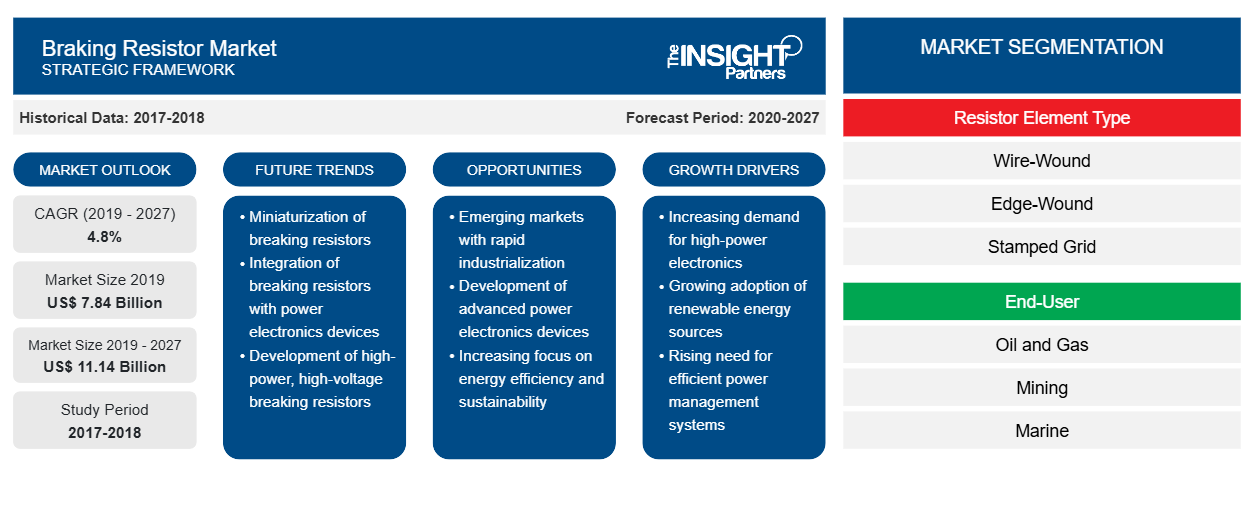Nel 2019, il mercato delle resistenze di frenatura era valutato 7.838,1 milioni di dollari USA e si prevede che raggiungerà 11.141,9 milioni di dollari USA entro il 2027; si prevede una crescita a un CAGR del 4,8% dal 2020 al 2027.
Una resistenza di frenatura o resistenze di frenatura dinamica (DBR) funzionano come azionamenti a frequenza variabile (VFD) a corrente alternata (CA) per disintegrare l'energia generata nel motore con l'aiuto della coppia frenante applicata per arrestare il motore. Questa resistenza ha la sua applicazione nel bus CC, che richiede una tensione di circa 800 volt quando vengono applicate le condizioni di frenata. Le resistenze di frenatura dinamica sono utilizzate nei sistemi di azionamento CC e negli inverter, e anche come motori di trazione elettrica nei veicoli ferroviari come generatori durante il rallentamento della locomotiva. Questa resistenza dinamica è anche nota come "reostatica", in quanto genera energia elettrica, che è rigenerativa se l'energia viene restituita alla linea di alimentazione e dissipata come calore nelle resistenze della griglia di frenatura. Questa resistenza genera una coppia frenante e assorbe l'energia extra generata al momento dell'arresto dei motori elettrici. Queste resistenze hanno la loro applicazione nei sistemi di azionamento a velocità variabile come gru, ascensori e treni. A causa della crescente urbanizzazione e crescita industriale, il consumo di energia è aumentato a dismisura. Pertanto, per soddisfare i crescenti requisiti di potenza, lo sviluppo di reti di trasmissione secondaria e intrastatale è in aumento. La crescente domanda di energia ed elettricità, dovuta all'aumento dei redditi delle famiglie e all'aumento delle industrie manifatturiere e pesanti, sta stimolando il mercato delle resistenze di frenatura. L'energia rinnovabile svolge un ruolo significativo nell'offrire accesso all'elettricità. Secondo l'Agenzia Internazionale per l'Energia (IEA), si prevede che la domanda di elettricità crescerà del 2,1% all'anno entro il 2040 in tutto il mondo. La domanda di elettricità nel Sud-Est asiatico è stata tra le più alte al mondo; ha potenziale per il settore delle energie rinnovabili. Si prevede che tutti questi fattori stimoleranno la crescita del mercato delle resistenze di frenatura durante il periodo di previsione.
L'Europa ha dominato il mercato delle resistenze di frenata nel 2019 e si prevede che continuerà a dominare durante il periodo di previsione. Gli investimenti tecnologici in Europa sono aumentati nel 2019 nonostante il rallentamento economico causato dalla tensione tra Regno Unito e Unione Europea (UE). I produttori di automobili hanno 304 stabilimenti di assemblaggio e produzione di veicoli in 27 paesi in tutta Europa. Nel 2019 è stata segnalata la produzione di 4.371.499 unità di veicoli commerciali e passeggeri. La crescente produzione di veicoli commerciali e passeggeri aumenta la domanda di integrazione di resistenze di frenata.
Personalizza questo report in base alle tue esigenze
Riceverai la personalizzazione gratuita di qualsiasi report, comprese parti di questo report, o analisi a livello nazionale, pacchetto dati Excel, oltre a usufruire di grandi offerte e sconti per start-up e università
-
Scopri le principali tendenze di mercato in questo rapporto.Questo campione GRATUITO includerà analisi di dati che spaziano dalle tendenze di mercato alle stime e alle previsioni.
Impatto della pandemia di COVID-19 sul mercato delle resistenze di frenata
L'emergere e la rapida diffusione del nuovo coronavirus (COVID-19) ha paralizzato numerosi paesi, sia sviluppati che in via di sviluppo. Il continuo aumento del numero di pazienti infetti sta minacciando diversi settori in tutto il mondo. A dicembre 2020, Stati Uniti, India, Brasile, Russia e Francia sono alcuni dei paesi più colpiti in termini di casi confermati di COVID-19 e decessi segnalati. L'epidemia sta influenzando negativamente le economie e le industrie in vari paesi a causa di blocchi, divieti di viaggio e chiusure aziendali. Inoltre, la domanda di resistori di frenatura sta diminuendo a un ritmo notevole perché i principali paesi acquirenti di resistori di frenatura stanno riducendo i loro investimenti in questi componenti e utilizzando una discreta percentuale del loro budget per combattere l'epidemia di COVID-19. La chiusura temporanea degli impianti di produzione sta inoltre ostacolando la crescita del mercato dei resistori di frenatura. La continuità della diffusione del COVID-19 frenerebbe la crescita degli operatori del mercato dei resistori di frenatura nei prossimi anni.
Approfondimenti di mercato
La crescente inclinazione verso i veicoli elettrici aumenta la domanda di resistori di frenata
I principali attori del settore automobilistico stanno investendo nella produzione di veicoli elettrici. Di recente, sono state intraprese collaborazioni notevoli tra case automobilistiche e aziende tecnologiche per sviluppare veicoli elettrici tecnologicamente avanzati. Ad esempio, a dicembre 2019, Fiat Chrysler ha collaborato con PSA Group, una casa automobilistica francese, per concentrarsi sullo sviluppo di veicoli elettrici. Inoltre, la crescente consapevolezza sui crescenti livelli di emissioni di gas serra e sugli impatti negativi dei veicoli convenzionali sono i principali fattori che incoraggiano i principali attori a investire nei veicoli elettrici. Diverse grandi aziende non vedono l'ora di investire in startup, che potrebbero eventualmente aiutarle a co-creare prodotti in futuro. Ad esempio, a marzo 2019, Hyundai, un produttore automobilistico con sede a Seoul, Corea del Sud, con la sua sussidiaria Kia, ha investito 300 milioni di dollari in Ola Electric per produrre soluzioni di mobilità e auto specificamente per la popolazione indiana. I veicoli elettrici utilizzano la frenata rigenerativa, che recupera l'energia persa durante la frenata e la invia alla batteria. In alternativa, è utile utilizzare una resistenza di frenata per scaricare l'energia in eccesso prodotta. Questi resistori sono utili in caso di guasti elettrici, nonché per ridurre i costi di manutenzione dovuti alla minore usura del sistema di frenata a frizione. Inoltre, l'energia dissipata durante la frenata dinamica nel resistore viene utilizzata anche per riscaldare il rimorchio o la cabina del veicolo; riducendo quindi la necessità di riscaldamento elettrico che pone un carico extra sulla batteria.
Approfondimenti di mercato basati sul tipo di elemento del resistore
In base al tipo di elemento del resistore, il mercato globale dei resistori di frenatura è segmentato in wire-wound, edge-wound, printed grid e altri. Il resistore wire-wound offre vantaggi significativi come un'eccellente dissipazione di potenza, antiurto e resistenza stabile. Questo resistore è utilizzato in diverse applicazioni, fondamentalmente come resistore di potenza, dove vengono dissipate grandi quantità di potenza. Il resistore wire-wound include un filo resistivo, che è avvolto attorno a un materiale non conduttivo. Generalmente, il filo resistivo è isolato in modo che i fili adiacenti non vadano in cortocircuito.
Approfondimenti di mercato basati sull'utente finale
In base all'utente finale, il mercato delle resistenze di frenatura è segmentato in petrolio e gas, estrazione mineraria, marina, automobile e ferrovie, energia e altri. L'aumento della domanda di autovetture e veicoli commerciali, soprattutto nei paesi in via di sviluppo, sta rafforzando la necessità di resistenze di frenatura per controllare la velocità e utilizzare la quantità eccessiva di energia dissipata. Nel 2014, la Cina ha segnalato la produzione di 24 milioni di veicoli, che si prevede aumenterà e raggiungerà circa 364 e 607 milioni entro il 2030 e il 2050, rispettivamente. Diversi produttori in tutto il mondo sono coinvolti nello sviluppo di diversi modelli di veicoli che richiedono l'integrazione di resistenze di frenatura. Pertanto, la crescente integrazione di resistenze di frenatura nel mercato automobilistico e ferroviario accelera la crescita del mercato delle resistenze di frenatura.
Approfondimenti regionali sul mercato delle resistenze di frenata
Le tendenze regionali e i fattori che influenzano il mercato dei resistori di frenata durante il periodo di previsione sono stati ampiamente spiegati dagli analisti di Insight Partners. Questa sezione discute anche i segmenti e la geografia del mercato dei resistori di frenata in Nord America, Europa, Asia Pacifico, Medio Oriente e Africa e America meridionale e centrale.

- Ottieni i dati specifici regionali per il mercato delle resistenze di frenata
Ambito del rapporto di mercato sulla resistenza di frenatura
| Attributo del report | Dettagli |
|---|---|
| Dimensioni del mercato nel 2019 | 7,84 miliardi di dollari USA |
| Dimensioni del mercato entro il 2027 | 11,14 miliardi di dollari USA |
| CAGR globale (2019 - 2027) | 4,8% |
| Dati storici | 2017-2018 |
| Periodo di previsione | 2020-2027 |
| Segmenti coperti |
Per tipo di elemento resistore
|
| Regioni e Paesi coperti |
America del Nord
|
| Leader di mercato e profili aziendali chiave |
|
Densità dei player del mercato delle resistenze di frenata: comprendere il suo impatto sulle dinamiche aziendali
Il mercato dei resistori di frenata sta crescendo rapidamente, spinto dalla crescente domanda degli utenti finali dovuta a fattori quali l'evoluzione delle preferenze dei consumatori, i progressi tecnologici e una maggiore consapevolezza dei vantaggi del prodotto. Con l'aumento della domanda, le aziende stanno ampliando le loro offerte, innovando per soddisfare le esigenze dei consumatori e capitalizzando sulle tendenze emergenti, il che alimenta ulteriormente la crescita del mercato.
La densità degli operatori di mercato si riferisce alla distribuzione di aziende o società che operano in un particolare mercato o settore. Indica quanti concorrenti (operatori di mercato) sono presenti in un dato spazio di mercato in relazione alle sue dimensioni o al valore di mercato totale.
Le principali aziende che operano nel mercato delle resistenze di frenatura sono:
- ABB Ltd.
- Bonitorone
- Società anonima
- RESISTENZE CRESSALL LTD.
- REO AG
Disclaimer : le aziende elencate sopra non sono classificate secondo un ordine particolare.

- Ottieni una panoramica dei principali attori del mercato delle resistenze di frenatura
Lo sviluppo del prodotto è la strategia comunemente adottata dalle aziende per espandere il proprio portafoglio prodotti. ABB Ltd., Vishay, Schneider Electric, Kanthal e Yashkawa sono tra i principali attori che implementano strategie per ampliare la base clienti e ottenere una quota significativa nel mercato globale delle resistenze di frenata, il che a sua volta consente loro di mantenere il proprio marchio. Alcuni degli sviluppi chiave recenti sono:
- Nel 2019, l'unità rigenerativa R1000 di Yaskawa Electric Corporation evita lo spreco di energia. Invece, viene restituita alla fonte di alimentazione che potrebbe essere utilizzata da altri carichi. L'unità rigenerativa R1000 è una soluzione più sicura per la rigenerazione rispetto all'elemento riscaldante aperto utilizzato nei resistori di frenatura dinamica.
- Nel 2018, Vishay Intertechnology, Inc. ha esposto i suoi ultimi resistori per sistemi di alimentazione per petrolio e gas, industriali, di trazione e di energia rinnovabile alla conferenza ed esposizione IEEE PES T&D del 2018.
Segmentazione del mercato delle resistenze di frenatura:
Per tipo di elemento resistore
-
- A filo avvolto
- Avvolto a bordo
- Griglia timbrata
- Altri
Da parte dell'utente finale
-
- Petrolio e gas
- Estrazione mineraria
- Marino
- Automobilistico e ferroviario
- Energia
- Altri
Profili aziendali
- ABB Ltd.
- Bonitorone
- Società anonima
- RESISTENZE CRESSALL LTD.
- REO AG
- Sandvik AB (Kanthal)
- Schneider elettrico
- Società internazionale Toshiba
- Vishay Intertechnology, Inc.
- Società elettrica Yaskawa
- Analisi storica (2 anni), anno base, previsione (7 anni) con CAGR
- Analisi PEST e SWOT
- Valore/volume delle dimensioni del mercato - Globale, Regionale, Nazionale
- Industria e panorama competitivo
- Set di dati Excel
Report recenti
Testimonianze
Motivo dell'acquisto
- Processo decisionale informato
- Comprensione delle dinamiche di mercato
- Analisi competitiva
- Analisi dei clienti
- Previsioni di mercato
- Mitigazione del rischio
- Pianificazione strategica
- Giustificazione degli investimenti
- Identificazione dei mercati emergenti
- Miglioramento delle strategie di marketing
- Aumento dell'efficienza operativa
- Allineamento alle tendenze normative























 Ottieni un campione gratuito per - Mercato delle resistenze di frenatura
Ottieni un campione gratuito per - Mercato delle resistenze di frenatura